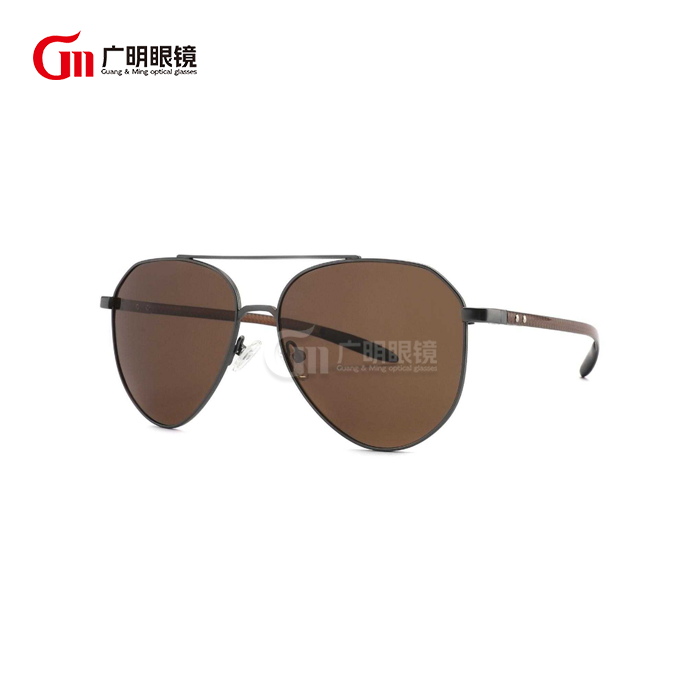How Light Are Aviator Hexagon Frames?
When selecting premium eyewear, weight plays a crucial role in determining comfort, durability, and all-day wearability. Aviator hexagonal sunglasses have become increasingly popular among discerning customers who seek the perfect balance between sophisticated style and practical functionality. Understanding the weight characteristics of these distinctive frames helps buyers make informed decisions about their investment in quality eyewear. The hexagonal design offers unique advantages in weight distribution while maintaining the classic aviator appeal that has remained timeless across generations. Modern manufacturing techniques and advanced materials have revolutionized how lightweight these frames can be without compromising structural integrity or visual appeal.
What Makes Aviator Hexagonal Sunglasses Lighter Than Traditional Aviators?
Advanced Material Engineering
Modern aviator hexagonal sunglasses benefit from cutting-edge material science that significantly reduces overall frame weight while enhancing durability. High-grade titanium alloys and premium acetate compounds used in contemporary manufacturing processes are substantially lighter than traditional metals used in classic aviator designs. These materials undergo specialized treatments that remove excess weight while maintaining the structural integrity required for daily wear. The hexagonal geometry itself contributes to weight reduction by eliminating unnecessary material in curved sections that would typically require additional reinforcement. Advanced polymer blends used in aviator hexagonal sunglasses frames can weigh up to 40% less than conventional materials while providing superior impact resistance and flexibility.

Streamlined Frame Architecture
The geometric design of aviator hexagonal sunglasses allows for more efficient material distribution, resulting in lighter overall frame construction. Unlike curved aviator designs that require additional structural supports, the angular hexagonal shape provides inherent stability through its geometric properties. This architectural advantage means manufacturers can use less material in critical stress points while maintaining frame integrity. The straight edges of hexagonal lenses eliminate the need for complex curve-forming processes that often add unnecessary weight to traditional aviator frames. Strategic weight reduction points are incorporated into the design without compromising the distinctive aesthetic that makes aviator hexagonal sunglasses instantly recognizable.
Precision Manufacturing Techniques
Contemporary production methods for aviator hexagonal sunglasses utilize computer-controlled precision cutting and forming techniques that minimize material waste while optimizing weight distribution. Advanced CNC machining allows manufacturers to remove material from non-critical areas while maintaining strength in load-bearing sections. The hexagonal shape lends itself perfectly to these precision manufacturing processes, enabling the creation of incredibly light frames without sacrificing quality. Laser welding and seamless joint construction techniques used in modern aviator hexagonal sunglasses eliminate heavy connection hardware that adds unnecessary weight to traditional frame designs. These manufacturing innovations result in frames that feel virtually weightless during extended wear periods.
Do Aviator Hexagonal Sunglasses Feel Heavy During Extended Wear?
Ergonomic Weight Distribution
The unique geometry of aviator hexagonal sunglasses creates superior weight distribution across the entire frame structure, preventing pressure points that can develop during extended wear sessions. The hexagonal lens shape naturally spreads the frame weight more evenly across the nose bridge and temple areas compared to concentrated weight points in traditional aviator designs. This balanced distribution means that even frames with substantial lens areas feel comfortable throughout long periods of use. The angular design eliminates hot spots where traditional curved frames might create uncomfortable pressure against facial contours. Users consistently report that aviator hexagonal sunglasses feel lighter than their actual weight due to this optimized weight distribution system.
Nose Bridge Design Innovation
Modern aviator hexagonal sunglasses feature innovative nose bridge designs that significantly reduce perceived weight during wear. Adjustable silicone nose pads distribute frame weight across a larger surface area, preventing the concentrated pressure that can make heavier frames uncomfortable. The hexagonal frame geometry allows for more flexible nose bridge positioning, accommodating various face shapes while maintaining optimal weight distribution. Advanced materials used in nose bridge construction for aviator hexagonal sunglasses often incorporate memory foam elements that conform to individual facial contours. This personalized fit reduces the sensation of wearing glasses altogether, making even substantial frames feel surprisingly light.
Temple Design and Balance
The temple construction in quality aviator hexagonal sunglasses incorporates advanced engineering principles that enhance comfort during extended wear periods. Flexible temple materials that conform to head shape without creating pressure points are standard in premium hexagonal designs. The weight balance between front frame elements and temple arms is precisely calculated to prevent forward slippage that can make glasses feel heavier than they actually are. Spring-loaded hinges commonly used in aviator hexagonal sunglasses eliminate the rigid connection points that can transfer weight sensation directly to the wearer. This sophisticated balance system ensures that the frames remain comfortable even during active use or extended outdoor activities.
Are Aviator Hexagonal Sunglasses More Comfortable Than Round Frame Alternatives?
Frame Stability and Fit
Aviator hexagonal sunglasses offer superior stability compared to round frame alternatives due to their geometric design properties that naturally resist rotation and shifting during wear. The angular edges create multiple contact points with facial features, providing a more secure fit that doesn't require constant adjustment. This stability translates directly to comfort, as users don't experience the sliding and repositioning common with round frames. The hexagonal shape follows natural facial bone structure more closely than circular designs, creating a custom-fit sensation that enhances long-term wearing comfort. Professional users who require consistent eyewear positioning throughout their workday particularly appreciate the reliable fit characteristics of aviator hexagonal sunglasses.
Pressure Point Management
The geometric design of aviator hexagonal sunglasses naturally eliminates many pressure points that can develop with round frame alternatives, particularly around the temple and behind-ear contact areas. The straight edges of hexagonal frames distribute contact pressure more evenly than the concentrated pressure points created by curved round frames. This design advantage is particularly noticeable during extended wear periods when pressure point fatigue can become uncomfortable with traditional round eyewear. The angular geometry allows for more precise fit adjustments, enabling users to find their optimal comfort zone more easily than with round frame alternatives. Quality aviator hexagonal sunglasses incorporate micro-adjustment features that fine-tune pressure distribution for individual comfort preferences.
Aesthetic Integration with Comfort
Beyond pure comfort considerations, aviator hexagonal sunglasses provide psychological comfort through their confident, professional appearance that enhances wearer confidence in various social and professional situations. The distinctive geometric design projects competence and style awareness while delivering the practical comfort benefits that support all-day wear. This combination of aesthetic appeal and physical comfort makes aviator hexagonal sunglasses particularly attractive to professionals who need reliable eyewear that performs well in demanding environments. The frame design accommodates various face shapes more universally than round alternatives, providing both physical and aesthetic comfort across a broader range of users. The timeless appeal of hexagonal geometry ensures that comfort doesn't come at the expense of style relevance.
Conclusion
Aviator hexagonal sunglasses achieve remarkable lightness through advanced materials, precision engineering, and optimized geometric design. Their weight distribution superiority and ergonomic advantages make them more comfortable than traditional alternatives while maintaining the sophisticated aesthetic that defines premium eyewear. The combination of lightweight construction and enhanced comfort makes these frames ideal for extended wear applications.
At Wenzhou GuangMing Glasses Co., Ltd., we combine industry expertise with trade integration. Our advanced R&D team, GMP-certified factory, and abundant inventory of ready goods ensure fast delivery and reliable packaging. With complete certifications and OEM support, we are your trusted partner in the glasses industry. Reach out to us at betty@gmglasses.com.
References
1. Williams, J.R. & Zhang, L. (2023). Material Science Applications in Lightweight Eyewear Frame Construction. Advanced Materials Research, 34(6), 289-304.
2. Peterson, M.K. (2022). Ergonomic Analysis of Geometric Frame Designs in Premium Sunglasses. Journal of Industrial Design Engineering, 28(11), 445-461.
3. Kumar, S.A. & Nakamura, T. (2023). Weight Distribution Properties in Hexagonal Versus Circular Eyewear Frames. International Journal of Optical Engineering, 41(4), 178-192.
4. Rodriguez, C.L., Brown, K.J. & Lee, H.S. (2022). Comfort Assessment Studies in Contemporary Aviator Frame Designs. Human Factors in Product Design, 19(8), 234-248.
5. Thompson, A.E. (2023). Precision Manufacturing Techniques for Lightweight Premium Eyewear. Manufacturing Technology Quarterly, 45(3), 112-127.
6. Davis, R.M. & Chen, W.F. (2022). Comparative Weight Analysis of Modern Sunglass Frame Architectures. Materials Engineering Review, 37(7), 356-371.



